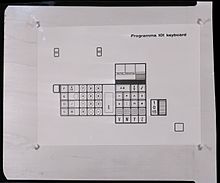
An electronic calculator is typically a portable electronic device used to perform calculations, ranging from basic arithmetic to complex mathematics.

The Intel 4004 is a 4-bit central processing unit (CPU) released by Intel Corporation in 1971. Sold for US$60, it was the first commercially produced microprocessor, and the first in a long line of Intel CPUs.

The IBM 650 Magnetic Drum Data-Processing Machine is an early digital computer produced by IBM in the mid-1950s. It was the first mass-produced computer in the world. Almost 2,000 systems were produced, the last in 1962, and it was the first computer to make a meaningful profit. The first one was installed in late 1954 and it was the most popular computer of the 1950s.
MIX is a hypothetical computer used in Donald Knuth's monograph, The Art of Computer Programming (TAOCP). MIX's model number is 1009, which was derived by combining the model numbers and names of several contemporaneous, commercial machines deemed significant by the author. Also, "MIX" read as a Roman numeral is 1009.

Federico Faggin is an Italian-American physicist, engineer, inventor and entrepreneur. He is best known for designing the first commercial microprocessor, the Intel 4004. He led the 4004 (MCS-4) project and the design group during the first five years of Intel's microprocessor effort. Faggin also created, while working at Fairchild Semiconductor in 1968, the self-aligned MOS (metal-oxide-semiconductor) silicon-gate technology (SGT), which made possible MOS semiconductor memory chips, CCD image sensors, and the microprocessor. After the 4004, he led development of the Intel 8008 and 8080, using his SGT methodology for random logic chip design, which was essential to the creation of early Intel microprocessors. He was co-founder and CEO of Zilog, the first company solely dedicated to microprocessors, and led the development of the Zilog Z80 and Z8 processors. He was later the co-founder and CEO of Cygnet Technologies, and then Synaptics.
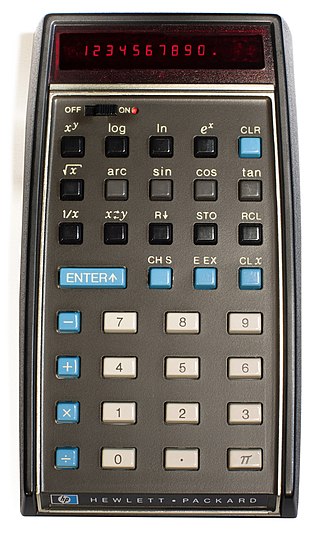
The HP-35 was Hewlett-Packard's first pocket calculator and the world's first scientific pocket calculator: a calculator with trigonometric and exponential functions. It was introduced in 1972.
4-bit computing is the use of computer architectures in which integers and other data units are 4 bits wide. 4-bit central processing unit (CPU) and arithmetic logic unit (ALU) architectures are those that are based on registers or data buses of that size. A group of four bits is also called a nibble and has 24 = 16 possible values.
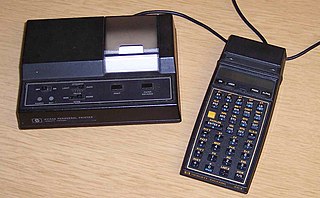
The HP-41C series are programmable, expandable, continuous memory handheld RPN calculators made by Hewlett-Packard from 1979 to 1990. The original model, HP-41C, was the first of its kind to offer alphanumeric display capabilities. Later came the HP-41CV and HP-41CX, offering more memory and functionality.

Olivetti S.p.A. is an Italian manufacturer of computers, tablets, smartphones, printers and other such business products as calculators and fax machines.

Mario Bellini is an Italian architect and designer. After graduating from the Polytechnic University of Milan in 1959, Bellini pursued a career as an architect, exhibition designer, product designer, and furniture designer during the Italian economic boom of the late 20th century. Bellini has received several accolades in a variety of design fields, including eight Compasso d'Oro awards and the Gold Medal for Lifetime Achievement by the Triennale di Milano. In 2019, the Italian President of the Chamber of Deputies, Roberto Fico, awarded Bellini a career medal in recognition of his contributions to Italian architecture and design.
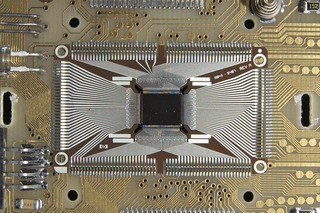
The Saturn family of 4-bit (datapath) microprocessors was developed by Hewlett-Packard in the 1980s first for the HP-71B handheld computer and then later for various HP calculators. It succeeded the Nut family of processors used in earlier calculators. The original Saturn chip was first used in the HP-71B hand-held BASIC-programmable computer, introduced in 1984. Later models of the family powered the popular HP 48 series of calculators. The HP48SX and HP48S were the last models to use genuine Saturn processors manufactured by HP. Later calculator models used Saturn processors manufactured by NEC. The HP 49 series initially used the Saturn CPU as well, until the NEC fab could no longer manufacture the processor for technical reasons in 2003. Therefore, starting with the HP 49g+ model in 2003, the calculators switched to a Samsung S3C2410 processor with an ARM920T core which ran an emulator of the Saturn hardware in software. In 2000, the HP 39G and HP 40G were the last calculators introduced based on the actual NEC fabricated Saturn hardware. The last calculators based on the Saturn emulator were the HP 39gs, HP 40gs and HP 50g in 2006, as well as the 2007 revision of the hp 48gII. The HP 50g, the last calculator utilizing this emulator, was discontinued in 2015 when Samsung stopped producing the ARM processor on which it was based.
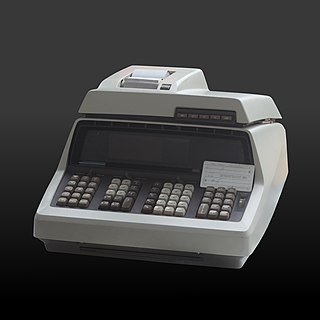
The Hewlett-Packard 9100A is an early programmable calculator, first appearing in 1968. HP called it a desktop calculator because, as Bill Hewlett said, "If we had called it a computer, it would have been rejected by our customers' computer gurus because it didn't look like an IBM. We therefore decided to call it a calculator, and all such nonsense disappeared."

The history of the personal computer as a mass-market consumer electronic device began with the microcomputer revolution of the 1970s. A personal computer is one intended for interactive individual use, as opposed to a mainframe computer where the end user's requests are filtered through operating staff, or a time-sharing system in which one large processor is shared by many individuals. After the development of the microprocessor, individual personal computers were low enough in cost that they eventually became affordable consumer goods. Early personal computers – generally called microcomputers – were sold often in electronic kit form and in limited numbers, and were of interest mostly to hobbyists and technicians.
Ferranti's Sirius was a small computer released in 1961. Designed to be used in smaller offices without a dedicated programming staff, the Sirius used decimal arithmetic instead of binary, supported Autocode to ease programming, was designed to fit behind a standard office desk, and ran on UK standard mains electricity with no need for cooling. It was also fairly slow, with instruction speeds around 4,000 operations per second, and had limited main memory based on delay lines, but as Ferranti pointed out, its price/performance ratio was difficult to beat.

The Elea was a series of mainframe computers Olivetti developed starting in the late 1950s. The system, made entirely with transistors for high performance, was conceived, designed and developed by a small group of researchers led by Mario Tchou (1924–1961), with industrial design by Ettore Sottsass. The ELEA 9001 was the first solid-state computer designed and manufactured in Italy. The acronym ELEA stood for Elaboratore Elettronico Aritmetico and was chosen with reference to the ancient Greek colony of Elea, home of the Eleatic school of philosophy. About forty units were placed with customers. In August 1964, only a few years after releasing the 9003, Olivetti's mainframe business was sold to GE.

The HP-67 is a magnetic card-programmable handheld calculator, introduced by Hewlett-Packard in 1976 at an MSRP of $450. A desktop version with built-in thermal printer was sold as the HP-97 at a price of $750. Collectively, they are known as the HP-67/97.

Pier Giorgio Perotto was an Italian electrical engineer and inventor. Working for the manufacturer Olivetti, he led a design team that built the Programma 101, one of the world's first programmable calculators.
Mario Tchou, also known as Tchou Wang Li, was an Italian engineer of Chinese descent. He was a pioneer of computer science in Italy, who led a group of scientists from the University of Pisa to invent in 1959 the Olivetti Elea—the world's most powerful computer at the time.
The Olivetti company, an Italian manufacturer of computers, tablets, smartphones, printers and other such business products as calculators and fax machines, was founded as a typewriter manufacturer by Camillo Olivetti in 1908 in the Turin commune of Ivrea, Italy. Olivetti was a pioneer in computer development, starting with the mainframe systems in the 1950s, and continuing into the 1990s with PC-compatible laptops and desktops.

